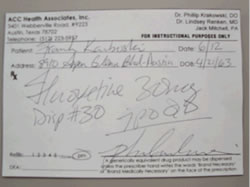Doctor's Orders
Doctor's orders refer to the amount of drug or dose in weight the doctor wants the patient to have. This can also be referred to as the given quantity or for our purposes, the start of the problem.
Doctors will use various abbreviations when writing an order. To be able to interpret the order and calculate the correct dosage, you will need to know and understand what those abbreviations stand for. It is necessary to commit these abbreviations to memory.
A doctor's order can be expressed in several ways:
- As a prescription to the patient - These orders are given to patients to be filled by a pharmacy.
- On a Medication Administration Record (MAR) - This document is used by nurses and othe health professionals to care for patients.
- As a standing order - These orders are mainly used by paramedics for emergency situations
Here is an example of a doctor's orders.

Sometimes doctor's orders are order dependent on a person’s weight. In other words, the doctor would like to have the medication dose based on the person's body weight. If the doctor's order is based on the patient's weight, it would be expressed as the amount of drug, or dose, in weight per kilogram of body weight.
In this example
the doctor would like the patient to have 75 milligrams of medication for every kilogram of body weight.
The wanted quantity , or desired amount, is the answer to the calculation problem or what you want the patient to receive; i.e. tablets, capsules, or milliliters(mL). This is also defined as what the health professional will administer to the patient for the correct dose.
This image shows the fluid amount of drug and tablets patient is to be administered.

